|
. Perhaps more
than that from any other time or region, the art and culture of ancient Egypt
has attracted the attention of the general public. To many "Egypt" signifies
our search into a mysterious and wondrous past-cities lost under the sands,
tombs filled with gold and the mummified remains of the dead, pyramids said
to hold unknown secrets, and scrolls revealing powerful spells, written in
a bold hieroglyphic script only decipherable to a few. Undoubtedly it is
our longing for these mysteries that fuel the audiences for movies like "The
Mummy," Discovery channel specials, as well as blockbuster traveling
exhibits, the most famous of which, featuring objects from King Tutankamen's
tomb, set off a "King Tut" craze around the world.
If you are looking for another glitzy, sensationalistic view of the Egyptian
world, however, Eternal Egypt: Masterworks of Ancient Art from the British
Museum will not be it. Due to an unparalleled opportunity 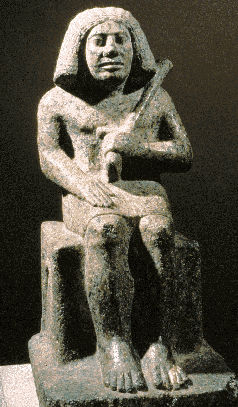 made possible
by the renovation of the British museum and organized along with the American
Federation of Arts, the exhibit features some of the most important works
from one of the most important collections of ancient Egyptian material in
the world. It is thus not surprising that the exhibit emphasizes these works
as "masterpieces" of Egyptian art rather than focusing on ancient objects
as evidence for everyday Egyptian life, as was the case for the highly successful
exhibit on view at the Brooklyn Museum five years ago, Mistress of the
House, Mistress of Heaven: Women in Ancient Egypt. What is surprising,
however, is that despite containing mostly "great" works, often of royal
figures, the exhibit remains scholarly in tone. There is gold here, along
with elaborate papyri scrolls, and towering colossi figures, but they are
meant to inform as much as be admired. made possible
by the renovation of the British museum and organized along with the American
Federation of Arts, the exhibit features some of the most important works
from one of the most important collections of ancient Egyptian material in
the world. It is thus not surprising that the exhibit emphasizes these works
as "masterpieces" of Egyptian art rather than focusing on ancient objects
as evidence for everyday Egyptian life, as was the case for the highly successful
exhibit on view at the Brooklyn Museum five years ago, Mistress of the
House, Mistress of Heaven: Women in Ancient Egypt. What is surprising,
however, is that despite containing mostly "great" works, often of royal
figures, the exhibit remains scholarly in tone. There is gold here, along
with elaborate papyri scrolls, and towering colossi figures, but they are
meant to inform as much as be admired.
Fig.1: Seated statue of Ankhwa, Old Kingdom, 3rd Dynasty (Copyright:
Trustees of the British Museum).
Arranged in
chronological order, the exhibit spans over 3,000 years of continuous development
in Egyptian art. It takes a careful observer to distinguish the changes in
Egyptian art styles over this long timeframe, however, as one of the hallmarks
of Egyptian culture is its reverence of tradition- "evolution" in Egyptian
art includes much looking to the past and deliberate archaism. Thus, it is
only by noting such details as the strong, broad features and characteristic
back-less stool that one can ascribe the seated figure of the royal shipbuilder
Ankhwa (fig.1) to the early Old Kingdom period (Dynasties 3-6; ca. 2686-2181
BC). We can see a similar simplicity and sturdiness in the Fourth Dynasty
statue of a woman, who, although she once wore a gold necklace and bracelet
(as evidenced by rough surfaces remaining on her chest and arms), has such
a strong, athletic figure that scholars th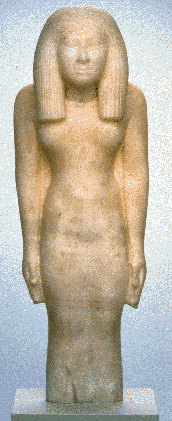 eorize that even royal women were
accustomed to physical labor in this early era (fig.2). eorize that even royal women were
accustomed to physical labor in this early era (fig.2).
The stockiness of these early Old Kingdom sculptures can be compared to more
elegant figures made of wood from the late Old Kingdom exhibited near-by.
Along with their longer, slender bodies and oversized heads with large, staring
eyes, figures from this period can be recognized by in an unusual departure--both
women and men are shown completely nude, without the usual Egyptian status
symbols of clothing and jewelry. A particularly fine example of this Sixth
Dynasty style in Egyptian art is the ebony statue of Meryrahashtef--a lithe
male figure, striding so that every muscle is clearly depicted with youthful
vigor.
Fig.2: A Royal Woman, Old Kingdom, 4th Dynasty, ca. 2613-2566 BC
(Copyright: Trustees of the British
Museum).
After the Old Kingdom period, unified political power in Egypt collapsed
and regional art styles reigned. Finally, King Mentuhotep II reunified Egypt
and heralded the early Middle Kingdom (Dynasties 9-11; ca. 2160-1985 BC),
a time of unprecedented strong, centralized government. A sandstone head
of Mentuhotep II from his funerary temple at Thebes clearly is meant to impress
the role of the King in this newly unified Egypt; he wears both the white
crown, a symbol of Upper Egypt, and the uraeus cobra, an emblem of royalty
denoting his a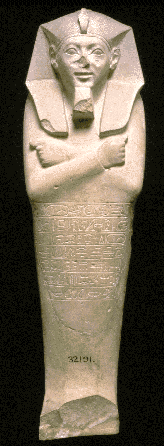 bility to "strike down" his enemies. Despite such formidable
regalia, Mentuhotep's wide-eyed expression is open and youthful, serious
without being stern. bility to "strike down" his enemies. Despite such formidable
regalia, Mentuhotep's wide-eyed expression is open and youthful, serious
without being stern.
The kings of the later Middle Kingdom (Dynasty 12; ca. 1985-1795 BC) moved
their capital from Thebes in southern Egypt to Lisht in the north, thereby
further solidifying their control over the country but also exposing them
to the archaic art styles still prevalent in the northern regions, such as
the sturdy muscularity evident in a depiction of Sesostris I. One of the
most famous statues from the Egyptian collection of the British Museum, portrays
King Sesostris III with a muscular, young physique but the somber, tight-lipped
expression of a mature and weary monarch. This may reflect the notion that
kings must be strong and forceful, but also bear a heavy burden of
responsibility, as expressed in Middle Kingdom poems.
Fig.3: Shabti statuette of Ahmose, New Kingdom, 18th Dynasty, ca.
1550-1525 BC (Copyright: Trustees of the British Museum).
After a time
of decentralization, Egypt was again unified under the reign of King Ahmose,
who expelled the foreign Hyksos from the land, thus beginning the New Kingdom.
A small burial statue is one of only three extant figures known to depict
this important king, and the only one that is complete (fig.3). Often considered
the "imperial age"of Egypt, the New Kingdom is marked by the increasingly
elaborate costumes and adornment of the elite, and the creation of sophisticated
temples and burial monuments. The exhibit features several impressive "colossal"
sculptures from the reign of Amenhotep III (ca. 1390-1352 B.C.). One is a
red granite lion, originally from the Amenhotep III's temple at Soleb (but
restored and reinscribed by King Tutankhamun), who sits in the relaxed,
cross-legged pose of one assured in his power, probably reflecting the absolute
rule of the king. A head 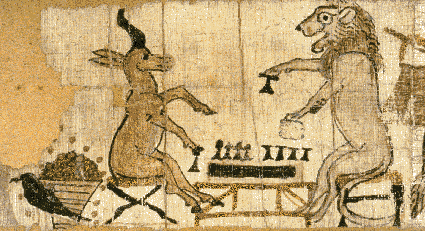 of Amenhotep III himself, wearing the red crown
of lower Egypt and the uraeus, has the same confident, serene expression-the
face of a ruler who dared to proclaim himself a god on earth. of Amenhotep III himself, wearing the red crown
of lower Egypt and the uraeus, has the same confident, serene expression-the
face of a ruler who dared to proclaim himself a god on earth.
Fig.4: Papyrus with satyrical vignettes, New Kingdom, 19th or 20th
Dynasty, ca. 1295-1069 BC (Copyright: Trustees of the British Museum).
Specific displays
focus on the creativity and artistic heights achieved during the New Kingdom.
Several objects provide information about the w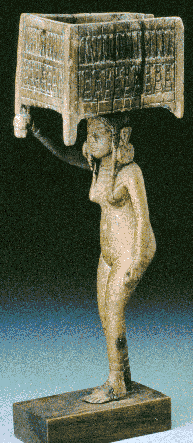 ork of Egyptian artist/scribes.
These include a scribal palette with depressions for reeds and pigments,
several practice sketches, and a slab inked with the grid which served as
the painter's guide. A papyrus shows several scenes, including one of a lion
and antelope happily playing a board game (fig.4), while nearby a fox, hyena
and wild cat herd goats and geese, which appear to satirize human nature
and may be the earliest known political cartoon. Another whimsical piece
is a cosmetic vessel held aloft by a young, nude woman (fig.5). A display
of jewelry attests to Egyptian skills in goldworking, as well as the apatropaic
powers ascribed to various animals and symbols. ork of Egyptian artist/scribes.
These include a scribal palette with depressions for reeds and pigments,
several practice sketches, and a slab inked with the grid which served as
the painter's guide. A papyrus shows several scenes, including one of a lion
and antelope happily playing a board game (fig.4), while nearby a fox, hyena
and wild cat herd goats and geese, which appear to satirize human nature
and may be the earliest known political cartoon. Another whimsical piece
is a cosmetic vessel held aloft by a young, nude woman (fig.5). A display
of jewelry attests to Egyptian skills in goldworking, as well as the apatropaic
powers ascribed to various animals and symbols.
Fig.5: Cosmetic vessel held by a girl, New Kingdom, 18th Dynasty,
ca. 1390-1352 BC (Copyright: Trustees of the British Museum).
Of course, no
exhibit of Egyptian artifacts would be complete without mummy covers and
other burial paraphernalia. A concept that is emphasized in Eternal Egypt
is that a large proportion of Egyptian art was created to help the deceased
live on in the afterworld. Coffin lids, for instance, were often covered
in images of rebirth and eternal life, such as sun disks and scarab beetles.
The dead were also richly arrayed on their journey to the afterworld, often
covered in gold (fig.6). Shabtis (also called shawabti or ushabti) are small
statuettes , usually only 4 to 9 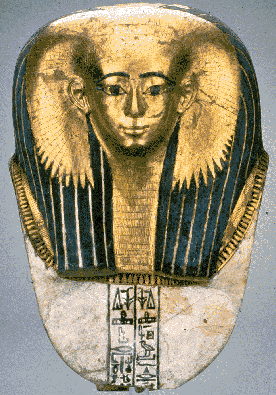 inches in height, which are were placed
in Egyptian tombs to serve as laborers for the deceased. Although holding
the agricultural tools (hoe and seed basket) which symbolize her willingness
to perform physical labor, and inscribed with a spell to impel her to work,
a 19th Dynasty shabti of a woman with fashionably clinging gown, heavy
kohl-painted eyes, "lipstick" and wig appears to be attired more for a night
on the town than a day in the fields. inches in height, which are were placed
in Egyptian tombs to serve as laborers for the deceased. Although holding
the agricultural tools (hoe and seed basket) which symbolize her willingness
to perform physical labor, and inscribed with a spell to impel her to work,
a 19th Dynasty shabti of a woman with fashionably clinging gown, heavy
kohl-painted eyes, "lipstick" and wig appears to be attired more for a night
on the town than a day in the fields.
Fig.6: Mummy mask of Satdjehuty, cartonnage, New Kingdom, 18th Dynasty,
ca. 1500 BC (Copyright: Trustees of the British Museum). Art during
the Third Intermediate (Dynasties 21-25; ca. 1069-656 BC) and early Late
Period (Dynasties 25 and 26; ca. 716-525 BC) imitated the earlier styles,
poses and costumes of the Old and Middle Kingdoms, although sometimes combining
these in new ways. Such archaism, as seen in the standing figure of Tjayasetimu,
attests to a deliberate attempt of later (often foreig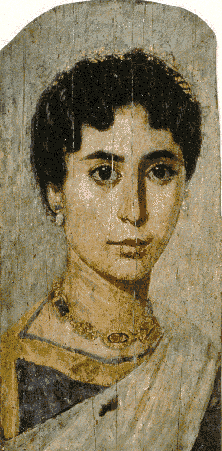 n) kings to associate
themselves with early, golden ages of a unified Egypt. n) kings to associate
themselves with early, golden ages of a unified Egypt. By the Ptolemaic period, Egypt was solidly part of the larger Hellenic world.
Although much of Egyptian culture was "westernized," other traditions lived
on. The Ptolemies were often depicted as pharoahs, a means of associating
themselves with the long history of Egyptian rulers. Even during the Roman
period, some of this essential "Egyptian" character was retained. The remains
of the dead were still mummified, but in a far different manner than before,
while the elaborate cartouches and gilded masks gave way to wooden panels
painted with naturalistic portraits of the deceased (fig.7). As evident in
the works on display in this exhibit, however, it the strong preservation
of tradition that attracts us to the mystery of "eternal" Egypt.
Fig.7: Panel portrait of a woman, Roman Period, ca. AD 160-170
(Copyright: Trustees of the British Museum).
. Reviewed by Michele A. Miller
This article appears on pp. 79-81 in the Museum Reviews section of Vol.3, No.2 of Athena
Review.
.
|
|